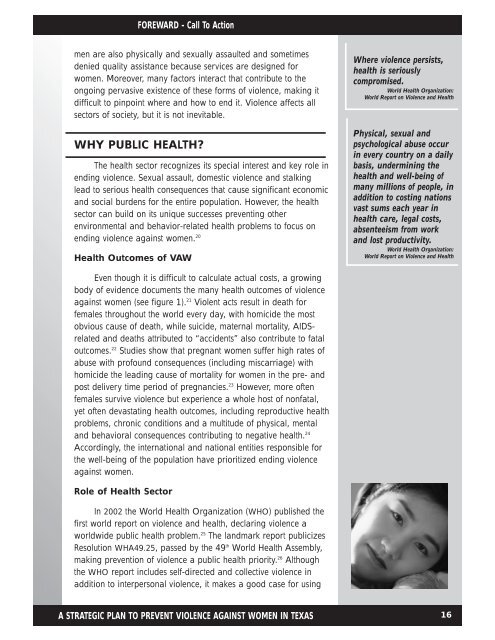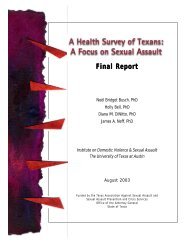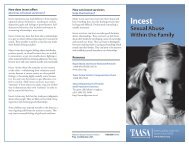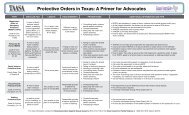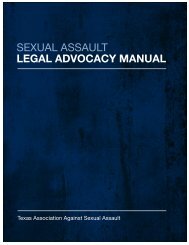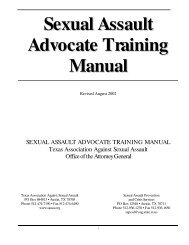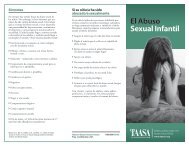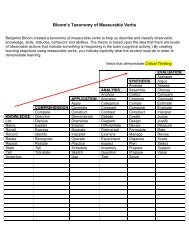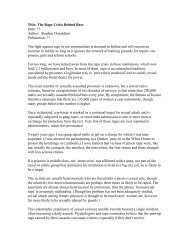TDH Booklet4 - Texas Association Against Sexual Assault
TDH Booklet4 - Texas Association Against Sexual Assault
TDH Booklet4 - Texas Association Against Sexual Assault
You also want an ePaper? Increase the reach of your titles
YUMPU automatically turns print PDFs into web optimized ePapers that Google loves.
FOREWARD - Call To Action<br />
men are also physically and sexually assaulted and sometimes<br />
denied quality assistance because services are designed for<br />
women. Moreover, many factors interact that contribute to the<br />
ongoing pervasive existence of these forms of violence, making it<br />
difficult to pinpoint where and how to end it. Violence affects all<br />
sectors of society, but it is not inevitable.<br />
WHY PUBLIC HEALTH?<br />
The health sector recognizes its special interest and key role in<br />
ending violence. <strong>Sexual</strong> assault, domestic violence and stalking<br />
lead to serious health consequences that cause significant economic<br />
and social burdens for the entire population. However, the health<br />
sector can build on its unique successes preventing other<br />
environmental and behavior-related health problems to focus on<br />
ending violence against women. 20<br />
Health Outcomes of VAW<br />
Where violence persists,<br />
health is seriously<br />
compromised.<br />
World Health Organization:<br />
World Report on Violence and Health<br />
Physical, sexual and<br />
psychological abuse occur<br />
in every country on a daily<br />
basis, undermining the<br />
health and well-being of<br />
many millions of people, in<br />
addition to costing nations<br />
vast sums each year in<br />
health care, legal costs,<br />
absenteeism from work<br />
and lost productivity.<br />
World Health Organization:<br />
World Report on Violence and Health<br />
Even though it is difficult to calculate actual costs, a growing<br />
body of evidence documents the many health outcomes of violence<br />
against women (see figure 1). 21 Violent acts result in death for<br />
females throughout the world every day, with homicide the most<br />
obvious cause of death, while suicide, maternal mortality, AIDSrelated<br />
and deaths attributed to “accidents” also contribute to fatal<br />
outcomes. 22 Studies show that pregnant women suffer high rates of<br />
abuse with profound consequences (including miscarriage) with<br />
homicide the leading cause of mortality for women in the pre- and<br />
post delivery time period of pregnancies. 23 However, more often<br />
females survive violence but experience a whole host of nonfatal,<br />
yet often devastating health outcomes, including reproductive health<br />
problems, chronic conditions and a multitude of physical, mental<br />
and behavioral consequences contributing to negative health. 24<br />
Accordingly, the international and national entities responsible for<br />
the well-being of the population have prioritized ending violence<br />
against women.<br />
Role of Health Sector<br />
In 2002 the World Health Organization (WHO) published the<br />
first world report on violence and health, declaring violence a<br />
worldwide public health problem. 25 The landmark report publicizes<br />
Resolution WHA49.25, passed by the 49 th World Health Assembly,<br />
making prevention of violence a public health priority. 26 Although<br />
the WHO report includes self-directed and collective violence in<br />
addition to interpersonal violence, it makes a good case for using<br />
A STRATEGIC PLAN TO PREVENT VIOLENCE AGAINST WOMEN IN TEXAS<br />
16


